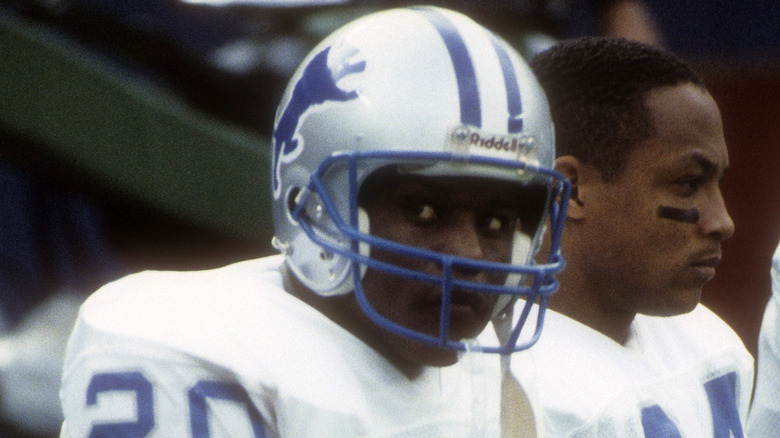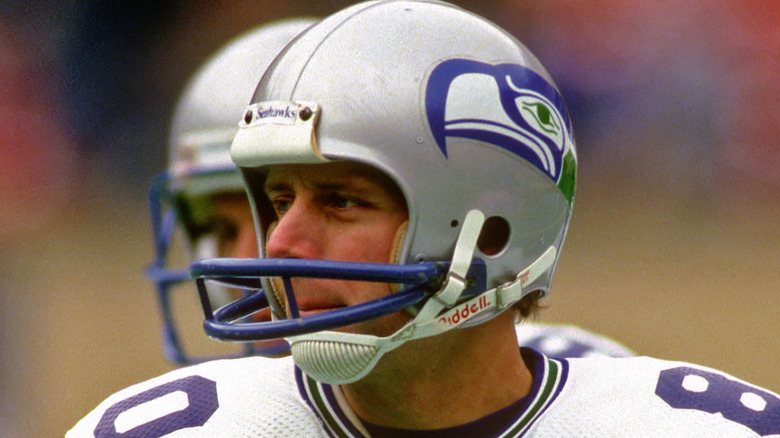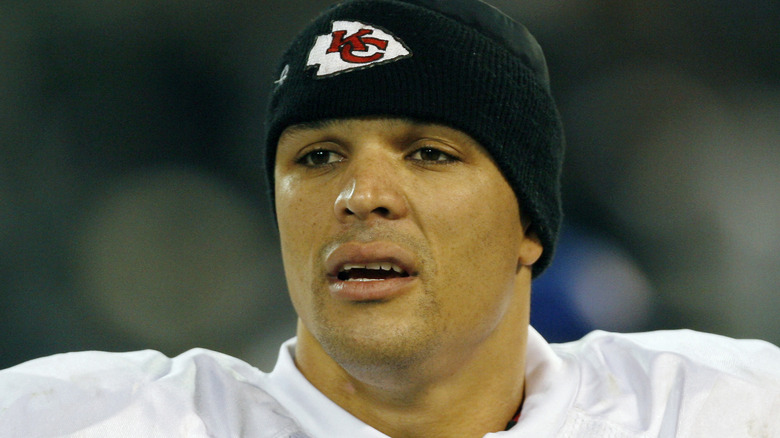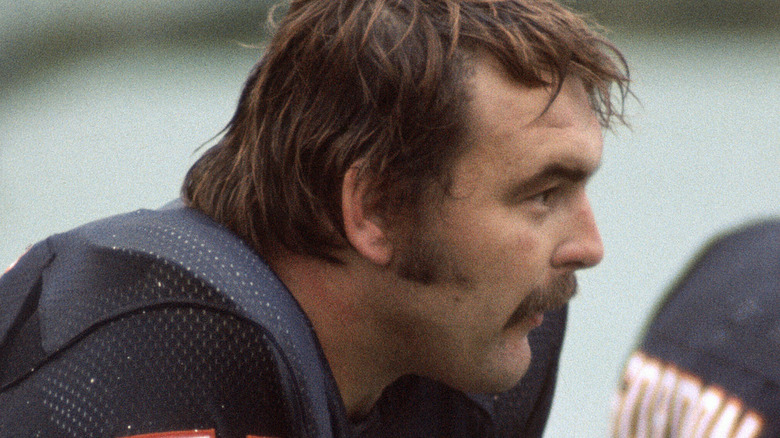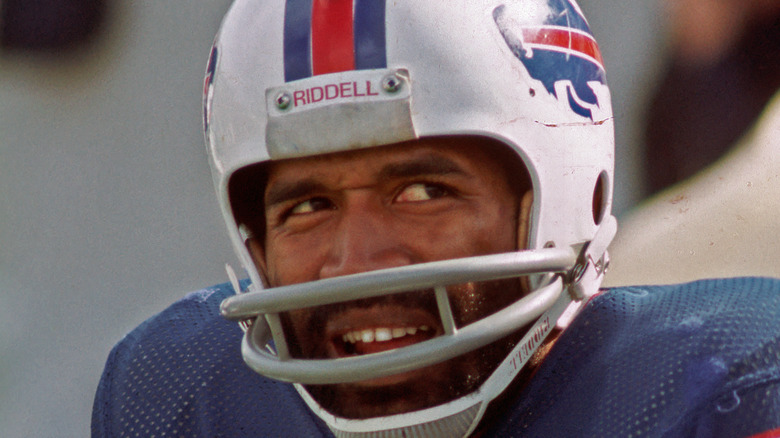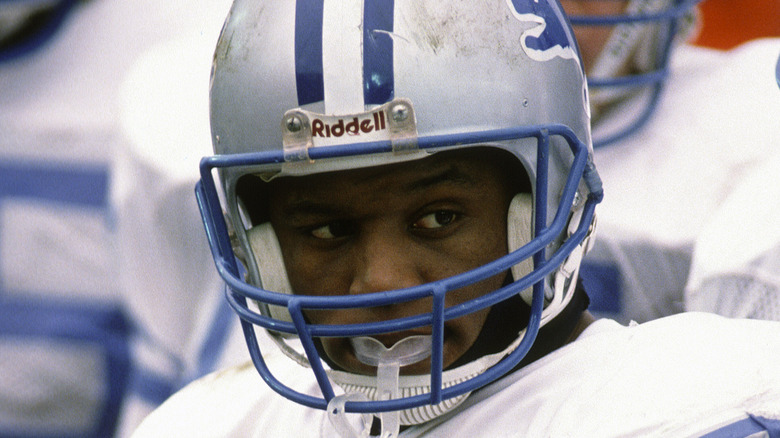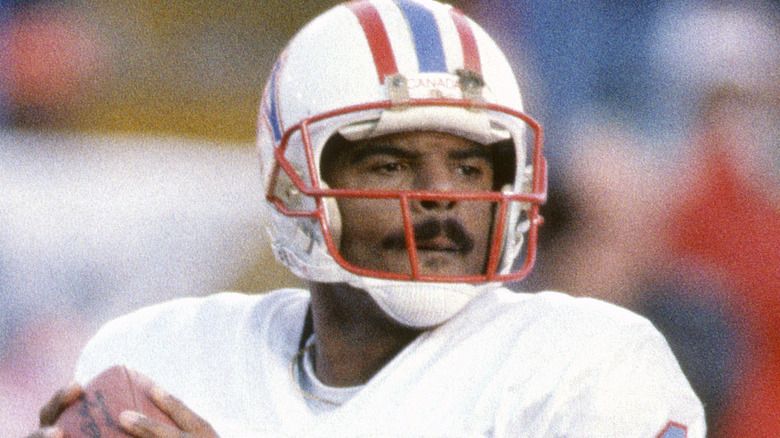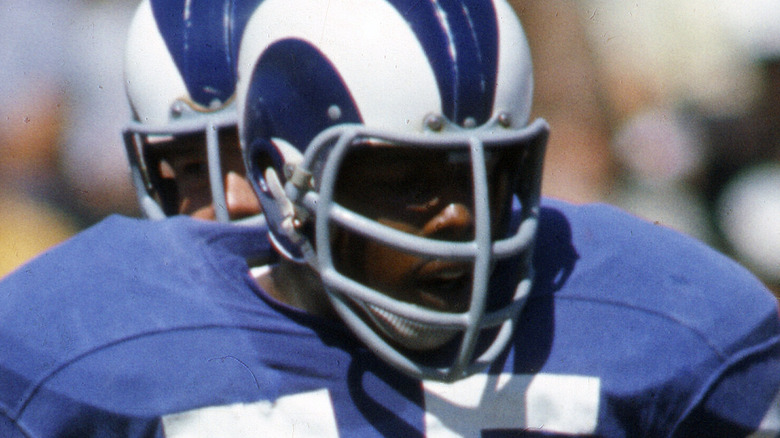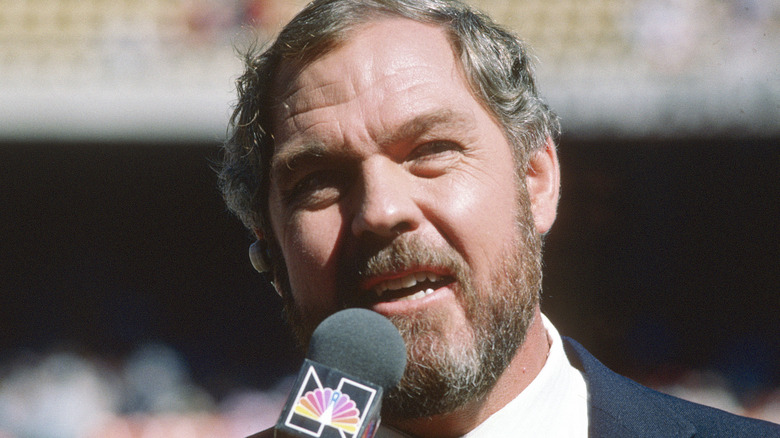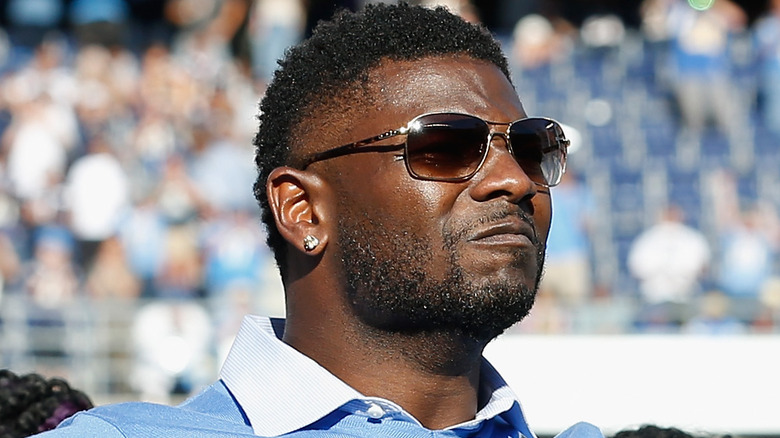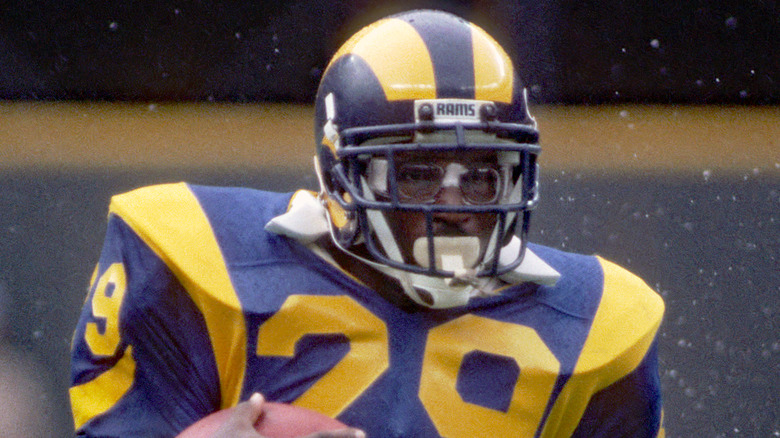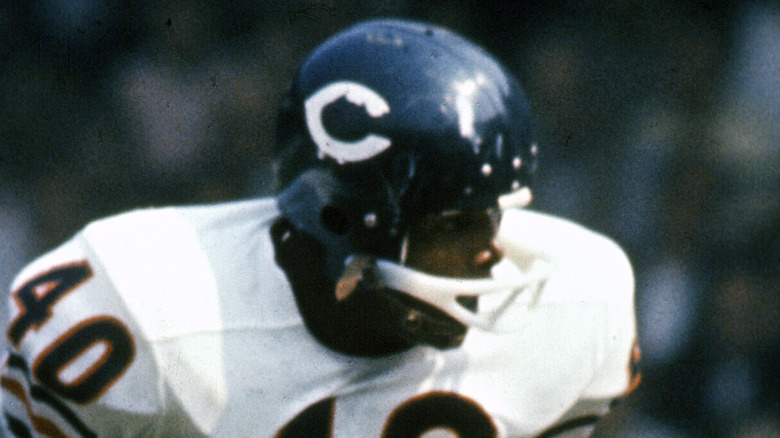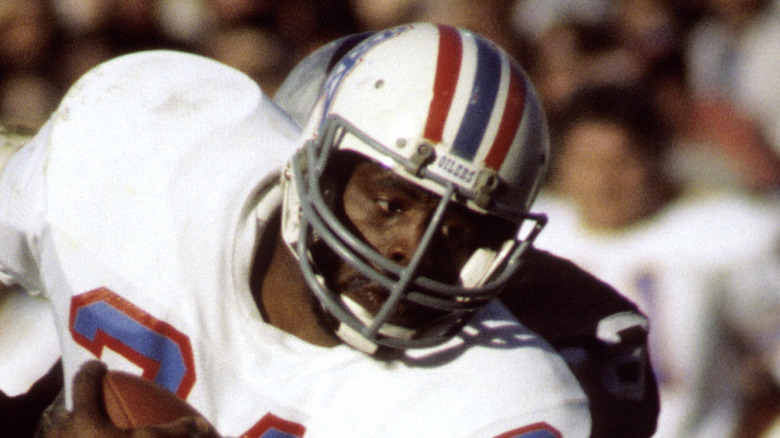The Greatest Football Players To Never Appear In A Super Bowl
2/14/23: A previous version of this article stated that the Rams never reached the playoffs during Deacon Jones' years. They made the playoffs three times during Jones' tenure.
The NFL's regular season is long, growing from 14 games in the '70s (according to CBS News) to 17 by 2022, providing four full months each year for players to tally up wins and impressive stat lines, en route to carving out careers that will someday get them inducted into the Pro Football Hall of Fame. But along with setting individual records, consistently winning games, and making indelible memories for fans and unbelievable stories for the history books, most NFL players really only ever want one thing — they're chasing that ring.
It's the end point of every season, and the determined destination for every man on every squad — to reach the Super Bowl, and play for a championship in front of 100,000 screaming fans and 100 million more watching on television. A little over 50 Super Bowls have ever been played, per Britannica, so winning one is a relatively rare achievement — rarer even than just participating in one.
As a result of this scarcity, and because of certain teams absolutely dominating their eras, a lot of the game's greats never won a ring or even got the honor to play in that big season-ending contest. Here then are some of the universally acknowledged best NFL players ever, who never got to experience the glory of playing in the Super Bowl.
Steve Largent (wide receiver)
Part of the original Seattle Seahawks roster in 1976, and a member of the team until the very end of the 1980s, Steve Largent was among the most reliable catchers and scorers of his generation. A seven-time Pro Bowl selection elected to the Pro Football Hall of Fame, as well as the institution's All-1980s team, Largent's stats (via Sports Reference) placed him at the top of a list of all wide receivers from both his era and NFL history.
In a 14-season career, Largent ranked among the top-10 players in receiving yards and receptions. In other words, he was one of the most consistently performing wide receivers for well over a decade. He's also one of just 10 wide receivers named to the NFL's 100th-anniversary team.
The only thing that really held back Largent during his years of bringing attention to the Seahawks and delighting appreciative Seahawks fans: He played for the Seahawks. As a team, they couldn't get it together in the '70s and '80s, usually finishing a season at just above .500 and making the playoffs only four times during Largent's tenure, according to Deseret News, winning their division once and advancing as far as a conference title game just once.
Tony Gonzalez (tight end)
In football, a sport where devastating injuries are the norm, Tony Gonzalez almost never missed a game (per Sports Reference). In a 17-year career with the Kansas City Chiefs and Atlanta Falcons, the tight end missed just two regular season games. And when he did play, he made major contributions to his team's offense, ranking in the top-10 in receptions five times, finishing at No. 3 on the all-time list, and in 2007 breaking the receptions record for tight ends (per the Pro Football Hall of Fame). In 2004, Gonzalez was particularly explosive, earning a league-leading 12.3 yards per touch. That season, Gonzalez landed on the Pro Bowl squad, just one of the 14 times he earned that honor.
When he retired, Gonzalez had racked up 1,325 successful catches, second only to Jerry Rice. Upon his first shot at eligibility for the Pro Football Hall of Fame, No. 88 was inducted and also named to the organization's All-2000s Team.
But catches don't always lead to a team scoring the most touchdowns in the most games. Gonzalez's time in Kansas City was a mediocre era for the Chiefs. They made it to the postseason three times in 12 years with Gonzalez, and lost in early rounds all three times. His three playoff appearances with the Falcons proved equally fallow, and Gonzalez never got to suit up for the Super Bowl.
Dick Butkus (linebacker)
Dick Butkus is the very mold of the ultra-tough, unstoppable, vicious linebacker (via Sports Reference). Nicknamed "The Enforcer," he played for the Chicago Bears from 1965 to 1973, and still holds league records in recovered fumbles in a single season and in a career. The two-time Defensive Player of the Year (and eventual Pro Football Hall of Famer) was selected to eight Pro Bowls, as well as the NFL's 100th-anniversary team, and the All-Decade Teams for both the 1960s and the 1970s.
One of the main reasons that Butkus never got to play in a Super Bowl was because the big inter-league championship game between the AFL and the NFL (later the AFC and the NFC) didn't become a regular thing until the late 1960s (per Britannica), by which point Butkus was ending his long and storied career.
In Butkus's Super Bowl-eligible years with the Chicago Bears, his team fared poorly, finishing with a 1-13 record at worse and a 6-8 record at best (per The Football Database), although before the AFL-NFL merger, Butkus's teams weren't much better. The squad's biggest superstar was a defensive force in Butkus, which didn't translate to many points on the board — Butkus's best regular season record with the Bears came in his rookie year of 1965.
O.J. Simpson (running back)
In the 21st century, O.J. Simpson is famous for things other than football, as related by AP. But well before his successful acting career in three installments of "The Naked Gun" (per IMDB), his imprisonment for forceful theft of sports memorabilia, and his monumental trial and acquittal for the brutal murder of his ex-wife, Nicole Brown Simpson, and her friend, Ron Goldman, O.J. Simpson was one of the best players in the history of the NFL (via Sports Reference).
The Buffalo Bills selected the Heisman Trophy-winning USC running back (per the Heisman Trophy Trust) with the No. 1 pick in the 1969 NFL Draft, who quickly and thoroughly dominated the league with his runs and carries. He led the NFL in rushing yards four times, rushing attempts three times, rushing touchdowns twice, and rushing yards per game three times. The Associated Press named Simpson the best offensive player and best overall player in the NFL in 1973, and then he got even better, with nobody scoring more points than he did in the 1975 season. After completing an 11-year career, the six-time Pro Bowler was inducted into the Pro Football Hall of Fame, and later named to the NFL's 100th-anniversary team.
Despite all those impressive stats and accolades, Simpson never came close to winning a championship ring. According to the San Francisco Chronicle, he never even played in a Super Bowl, with his teams only making the playoffs just once, in 1974.
Barry Sanders (running back)
A 2,000-yards rushing season is an exceedingly rare achievement for a running back, according to Sports Reference. It's only happened eight times in NFL history, and in 1997 Detroit Lions star Barry Sanders did it, rushing for 2,053 yards. He's also the only player to appear twice in the top-10 all-time individual season rushing yards list — in 1994, he amassed 1,883 yards. Only three players ever accumulated more career rushing yards than Sanders did — Emmitt Smith, Frank Gore, and Walter Payton, the latter being the all-time leader at the time that Sanders retired after a truncated 10-season career in 1998 (per ESPN), just 31 yards away from breaking it.
Altogether, Sanders led the NFL in rushing and yards per game four times in those ten years, and he was named to the Pro Bowl every single time. CBS Sports called his 1997 campaign, in which he was voted the NFL's best player by the Associated Press and the Sporting News, the greatest ever for a running back. Sanders cruised into the Pro Football Hall of Fame in 2004.
One accomplishment that escaped Sanders: a Super Bowl ring, or even an appearance. His Detroit Lions reached the postseason five times on the strength of Sanders' performances, but they couldn't go all the way. The farthest they got was the 1991 NFC title game, in which Washington blew out Detroit 41 to 10.
Warren Moon (quarterback)
The NFL of the 1980s and 1990s was a big era for quarterbacks, so much so that a few teams took repeats trip to the Super Bowl because of their strong-armed offensive captains, like Dan Marino and the Miami Dolphins (per Sports Reference). One of the few QBs who could give those legends a run for their money when they were all at the height of their careers was Warren Moon.
After five years in the Canadian football League, Moon entered the NFL in 1984 with the Houston Oilers and served late-career stints with the Minnesota Vikings, Seattle Seahawks, and Kansas City Chiefs. He was an architect of the comeback, leading 25 fourth-quarter come-from-behind victories with 35 game-winning late drives.
The nine-time Pro Bowl selection retired in 2000, according to the Pro Football Hall of Fame (where he's an inductee), but he still holds the NFL records in most 300-yard passing games in a season (nine in 1990), most own-fumbles recovered (56), and most completed passes in a season (404 in 1991). Moon remains the all-time franchise leader in 16 offensive categories for the Houston Oilers, now the Tennessee Titans. Moon led his teams to postseason berths seven times — but they never made it so far as a conference championship game.
Deacon Jones (defensive end)
Teams feared the Los Angeles Rams in the 1960s because of its imposing and intense defensive line nicknamed the "Fearsome Foursome" (per the Los Angeles Times), led by 6-feet-5-inches tall, 272-pound defensive end David "Deacon" Jones (via Sports Reference).
The NFL didn't keep official or precise track of sacks before the 1982 season, but knocking down the opposing team's quarterback before he even had a chance to throw the ball was Jones' specialty. He led the NFL in sacks five times in the 1960s, with as many as 22 per season on two occasions, averaging nearly one per game across his entire 14-season career. He also scored more than the usual defense-only defensive player, scoring an ultra-rare safety in 1965 and 1967, leading the NFL in that stat both times.
Named to the NFL's 100th-anniversary team and the Pro Football Hall of Fame, Jones participated in seven consecutive Pro Bowls despite playing for a lackluster Los Angeles Rams. During Jones' years in L.A., the Rams finished at or near the bottom of their division, only making playoffs three times, and never a Super Bowl.
Merlin Olsen (defensive tackle)
Another standout member of the Los Angeles Rams' "Fearsome Foursome" defensive line: Merlin Olsen, a left defensive tackle (via the Los Angeles Times). Olsen spent his entire 15-year career in the 1960s and 1970s with the Rams, during which time he was voted to 14 Pro Bowls and won the 1974 Bert Bell Award for best player in the NFL (per Sports Reference).
While he'd later win over a whole new generation of fans as an NBC Sports commentator and actor, playing gentle characters on rural period pieces "Little House on the Prairie" and "Father Murphy," per The New York Times, Olsen was a frightening, 6-feet-5-inches tall, 270-pound lineman.
A member of both the College Football Hall of Fame, the Pro Football Hall of Fame, and the NFL's 100th-anniversary team, Olsen has been well recognized for his list of accomplishments. Not on that list: a Super Bowl ring. Olsen's Rams may have been notorious for their defensive lines, but they could barely scrape together a winning record. When he did reach the postseason, it ended in disappointment — he and the Rams lost three consecutive NFC Championship Games from 1974 to 1976.
LaDainian Tomlinson (running back)
In the early years of the 21st century, there was no more dominant and spectacular running back than the San Diego Chargers' LaDainian Tomlinson. In 2006, Tomlinson had the best year of his career or anyone else in the NFL at that time, per Sports Reference. He won the NFL's Bert Bell Award for greatest player and was named the best by both the Associated Press and the Pro Football Writers of America.
The running back led all others with 1,815 rushing yards, 28 touchdowns, and 113.4 yards per game. He'd lead the NFL in yards and touchdowns again in the 2007 season, and he'd finish his 11-year Hall of Fame career in 2011 with five Pro Bowl selections. As of 2023, Tomlinson sits in seventh place on the all-time rushing yards list.
But none of those heroics could quite get Tomlinson to a Super Bowl. According to ESPN, his Chargers came close in 2006, finishing with a stellar regular season record, but were eliminated in an AFC divisional playoff game at home against the New England Patriots.
Eric Dickerson (running back)
Immediately upon his entry into the NFL, two-time collegiate All-American running back Eric Dickerson (per Sports Reference) laid the groundwork for a career that would eventually lead to his enshrinement in the Pro Football Hall of Fame. Dickerson put on one of the greatest all-time rookie performances, topping the leagues for rushing attempts and rushing yards (1,808).
He'd get more rushing yards than anyone else in the NFL in three more seasons, and finish with more than 13,000, placing Dickerson among the top-10 most prolific running backs ever. He routinely collected awards for his regular play, including three Offensive Player of the Year nods from the UPI, an AP Offensive Player of the Year award, and five All-Pro selections.
And yet, in his historic 12-year career, Dickerson's teams only reached the postseason five times — his first five years. Neither the Los Angeles Rams nor Indianapolis Colts could get any farther than the second round of the playoffs, denying Dickerson a chance to run a Super Bowl touchdown.
Gale Sayers (halfback)
Gale Sayers' NFL playing career was decidedly short, spanning just five full seasons in the late 1960s, and entirely with the Chicago Bears (via Sports Reference). But the running back put up such consistently high and dazzling numbers that it earned him entry into the Pro Football Hall of Fame and a slot on the NFL's 100th-anniversary team. His 1965 and 1969 seasons alone featured some of the best ever stats ever put up by a running back. In the former, he rushed for 1,231 yards, averaging 87.9 a game, and in the latter, he rushed for 1,032 yards, good for 73.7 per game.
Named the NFL's top offensive rookie by the Associated Press, UPI, and Sporting News, Sayers was a high school track star, which gave him the speed and moves he needed to zip past linemen, according to the AP. One of the most effective and unstoppable kick returners, Sayers once returned from a potentially career-ending knee injury to lead the league in rushing.
Sayers' era just barely overlapped with the NFL's early stabs at the Super Bowl, and he never got to play in one. Besides that, his Bears never reached a championship game in the pre-merger NFL.
Earl Campbell (running back)
The No. 1 pick in the 1978 NFL Draft, Earl Campbell came to the NFL with a lot of hype, a Heisman Trophy winner, and a consensus All-American (via Sports Reference). The running back delivered: In 1978, he earned Rookie of the Year as well as the NFL's MVP award for the first of four seasons, in which he'd lead the AFC in rushing yards and yards per game. In 1980 alone, he amassed what was at that point the second-most yards ever in a season, including four straight 200-yard games.
Having never even gotten the opportunity to win a Super Bowl is the one thing that rattled Campbell, even more than three decades after he retired after the 1985 season. "There are times I wish I had a Super Bowl ring," he told the Houston Chronicle in 2017. "For a Hall of Famer, that's one thing that sums up your career: having a Super Bowl ring."
Campbell figures the Oilers could have made a run in the early 1980s under coach Bum Phillips. "But they fired Bum, and that broke the nucleus of the way we approached the game and the way we felt about the game." As such, Campbell and the Oilers made it as far as the AFC title game in 1978 and 1979, blown out both times by the Pittsburgh Steelers.
